Panzerfaust
WW II German Infantry Anti-Tank Weapons
Page 9: Hand Grenades & Related Anti Tank Devices
Molotovcocktail
One of the most primitive, easily ad-hoc manufacturable yet early in
the war rather effective AT devices was what has become known as the Molotov
cocktail or simply the Molotov. This is essentially a regular glass bottle
filled with highly flammable liquid, plugged by a cloth drenched with flammable
liquid and set afire before throwing the weapon. Upon impact, the bottle
breaks and the contained liquid is ignited from the cloth and the burning
fuel is sprayed over the target. Although all combinations of flammable
liquids essentially work for this kind of fire bomb, it is preferred to
use a mixture of a longer lasting and more intensely burning ingredient
such as oil or tar that will also stick to the target better, and a more
volatile ingredient such as gasoline that will ensure ignition of the mixture
upon impact. The name Molotov is related to the known russian foreign secretary
of the 1930ies. Molotov's are still widely used as a weapon of terrorists,
guerilla forces and revolting citizen since the means necessary to build
them are easy to obtain; almost daily they can be seen in the news used
by violent demonstrators everywhere in the world.
Molotov's were used to quite some success by the fins in the Winter
War against isolated russian tanks. Naturally, the effectiveness of these
weapons deteriorated against the newer tank designs late in the war; the
problems are the same encountered with using flamethrowers
against tanks: the flaming liquid needs to ooze into the vulnerable interior
of the tank or heat up exposed fuel or ammunition to cook it off. The newer
tanks sometimes addressed these vulnerable aspects by an increased overall
armor and special air venting and other means to protect the engines from
being attacked with Molotov - type weapons.
Although the german forces like any other, especially the russian, forces
made up their own ad-hoc Molotov weapons of glass bottles filled with flammable
liquids, the germans also standardised this weapon and factory - mass-produced
them in large quantities.
The first such weapon was the Brandflasche ("flame/incendiary
bottle"). It was a glass bottle that was 25cm high and had a diameter
of 7cm. It was filled with one third of the same flaming liquid that was
also used by the flamethrowers and called Flammöl ("flame
oil") and two thirds gasoline.
The other Molotov - weapon was the Brandhandgranate 48/57 ("flame/incendiary
hand grenade"). It was a glass container of 10cm height and 8cm diameter.
It contained 0.5 liters of a mixture of gasoline fuel and benzole.
Handgranate
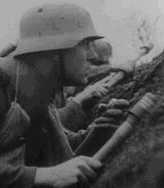 Handgrenades
are often used against tanks, usually not due to any special AT capability
of these weapons but because of their availability. Although a regular
handgrenade could not kill a healthy full-grown tank it might damage it
esp. immobilize it with a lucky explosion in the track. But there were
also special AT handgrenades dedicated to fight armor.
Handgrenades
are often used against tanks, usually not due to any special AT capability
of these weapons but because of their availability. Although a regular
handgrenade could not kill a healthy full-grown tank it might damage it
esp. immobilize it with a lucky explosion in the track. But there were
also special AT handgrenades dedicated to fight armor.
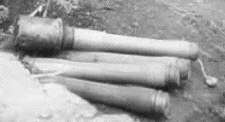 The
most famous german hand grenade is probably the Stielhandgranate 24
("stick hand grenade"), often referred to as the stick grenade
or the potato masher by allied soldiers. The grenade's time fuse was activated
by unscrewing the bottom and pulling the Abreisszünder ("rip
detonator") safety cord (see picture at right). It weighed 480g, had
an overall length of 35.6cm and had a warhead with a length of 7.5 cm and
a diameter of 6cm that contained 165g of explosives (different explosives
were used over the course of the war).
The
most famous german hand grenade is probably the Stielhandgranate 24
("stick hand grenade"), often referred to as the stick grenade
or the potato masher by allied soldiers. The grenade's time fuse was activated
by unscrewing the bottom and pulling the Abreisszünder ("rip
detonator") safety cord (see picture at right). It weighed 480g, had
an overall length of 35.6cm and had a warhead with a length of 7.5 cm and
a diameter of 6cm that contained 165g of explosives (different explosives
were used over the course of the war).
The cylindrical warhead was also available as a hand grenade without
the stick under the designation Handgranate 43. This cylindrical
warhead could be used for other purposes: combined with a pressure-activated
trigger they served as mines.
Several Handgranate 43 warheads could also be combined with a Stielhandgranate
to make a large explosive grenade bundle. This combination of one Stielhandgranate
24 with 6 of the same warheads without the stick was very popular and often
referred to as the "Geballte Ladung" ("forceful/big
charge")  by
the troops although this designation is rather colloquial and was actually
semi-officially in use for an engineer weapon. The complete weapon combination
looked like a flower with the grenade stick of the central Stielhandgranate
as the stalk and the Hd.Gr.43 warheads surrounding it like petals (see
sketch at right). It was often used as an improvised makeshift AT weapon.
by
the troops although this designation is rather colloquial and was actually
semi-officially in use for an engineer weapon. The complete weapon combination
looked like a flower with the grenade stick of the central Stielhandgranate
as the stalk and the Hd.Gr.43 warheads surrounding it like petals (see
sketch at right). It was often used as an improvised makeshift AT weapon.
To increase the shrapnel effect (the handgrenades had a very thin metal
skin and were intended to rely on blast rather than fragmentation) later
the Splitterringe ("shrapnel rings"; see picture of Panzerfaust
150) could be attached to the cylindrical warhead; use of these shrapnel
rings was copied from the russians who used this method for their RGD 33
hand grenades.
Of both the Stielhandgranate 42 and the Handgranate 43 together
a total of 81 Mio. were produced before and during the war.
 A
smaller handgrenade was the Eihandgranate 39 ("egg hand grenade").
It weighed only 230g and contained 112g of explosives; it's small size
reduced the lethality of the weapon but greatly improved handling and conveniant
stowage. Having a length of 7.6cm and a diameter of 6cm, a total of 84
Mio. Ei-Hdgr. 39 were produced beginning in early 1940.
A
smaller handgrenade was the Eihandgranate 39 ("egg hand grenade").
It weighed only 230g and contained 112g of explosives; it's small size
reduced the lethality of the weapon but greatly improved handling and conveniant
stowage. Having a length of 7.6cm and a diameter of 6cm, a total of 84
Mio. Ei-Hdgr. 39 were produced beginning in early 1940.
Later in the war due to shortages Eihandgranaten were manufactured of
concrete (with scrap metal pieces in the cast) instead of metal. Because
these concrete egg grenades had problems with the concrete becoming brittle,
another solution was found: the Volkshandgranate 45 ("people's
hand grenade"). It was basically a cardboard can with a diameter of
5cm and a height of 7cm filled with a mixture of 70g concrete, 75g gravel
and 350g scrap metal pieces, with a core made of only 36g of explosive
(due to shortages). The can was closed with a sheet metal lid with the
same Abreisszünder rip-cord used on the Stielhandgranate. The company
Preussag in Rudersdorf produced 784,200 beginning in January 1945.
Shortages in critical raw material had also led to the development of
the Behelfshandgranate ("makeshift hand grenade"), which
was introduced in March 1943. It weighed 550g and consisted of a concrete
pot with a length of 9cm and a diameter of 7cm, into which the explosive
(Bohrpatrone 28 explosive cartridge) and a wooden stick were cast.
An invention that was not really a normal handgrenade but shall be mentioned
here as a rather interesting idea were the so-called Detonierende Pulverscheibe
("detonating powder disc"), often abbreviated as DPS and
later designated by the army as Scheibenhandgranaten ("disc
hand grenades") were discs maufactured from Nipolite. Nipolite was
a newly invented explosive that didn't require a casing and was easy to
manufacture. They were intended as AT devices: the discs had a diameter
of 8cm and were only 1.6cm thick. they were to be inserted into the observation
slits of tanks. The discs weighed 125g of which 87g were explosive. Several
discs could be combined to increase effect. The company WASAG also developed
a version of their invention to be used against bunkers and fortified positions
which weighed 1kg of which 450g were a combination a Nipolite and phosphor.
However, a production of these close-range AT weapons has probably not
started since other means of fighting armor such as the Panzerfaust had
been developed in the meantime.
Rollbomben
The Rollbomben ("roll bombs") weapons are closely related
to the Handgranaten, although they carried a considerably bigger punch.
The smallest model weighed 1kg and contained 700g of explosive; bigger
models contained 3 and 3.5kg of explosives respectively. A monster in this
family was the Rollbombe 30kg, It was a large ball of 30cm diameter
and weighing 30kg made of reinforced concrete with 4kg of scrap metal pieces
cast in that contained 5.5kg of explosives. It's detonation reportedly
was of spectacular effect.
Nevertheless, the Rollbomben never grew beyond being a rather odd weapon
and weren't too numerous.
Nebelhandgranaten & Blendkörper
Nebelhandgranaten ("smoke hand grenades") could be
used to mask and protect from enemy fire. The first pre- and early war
model was the Nebelhandgranate 39. It weighed 720g and resembled
the Stielhandgranate 24 in outward appearance. The warhead
however here contained 420g of a mixture of zinc powder and hexachlorethane
which produced a smoke cloud upon detonation. An improved successor model,
the Nebelhandgranate 41, was a can (6.6cm diameter; 7.3cm length)
without the stick and weighed 530g, which included 440g of the same smoke
mixture used in its predecessor.
7,393,200 Nebelhandgranaten were produced during WW II (plus
65,100 from pre-war production) until production was switched over in 1943
to the Nebeleihandgranate ("smoke egg hand grenade").
The latter had a diameter of 6cm and a length of 13.5cm. A total of 1,835,500
were produced until the end of the war.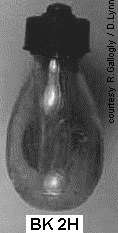
A closely related weapon family to the Nebelhandgranaten were
the Blendkörper ("blinding devices"), although the
latter were intended as a designated AT weapon. Introduced in 1943, the
first model Blendkörper 1 H or BK 1H weighed 370g and
was a little unwieldy at a diameter of 6cm and a length of 15cm. Therefore,
after 225,200 BK 1H production was switched over to the second model,
the BK 2H. This was a glass bottle with a length of 12.8cm. It contained
290g of a mixture of calcium chloride / titan tetrachloride / siliciumterachloride
which were separated from each other with by a disc. The whole device weighed
400g.
The idea behind the Blendkörper was that when thrown, the explosion
blinded the crews of enemy tanks. Then, the ensuing smoke cloud with irritant
was to make the crew exit their vehicle. Despite appearing to be a bizarre
weapon, the Blendkörper were rather common in use. 5,142,800 of the
BK 2H were produced and practically all were used up until the end
of the war.
Panzerhandgranaten
The first special AT hand grenade was the Panzerhandgranate 41.
It weighed 2kg and was effective against armor of up to 30mm thickness.
504,600 were produced in early 1943. Further developments of AT handgrenades
utilising shaped charges 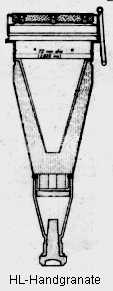 had
trouble stabilizing the flight which was necessary for the shaped charge
to work (this lead to the development of the Panzerwurfmine).
had
trouble stabilizing the flight which was necessary for the shaped charge
to work (this lead to the development of the Panzerwurfmine).
 The
SS-weapon's academy then invented the HL-Handgranate that was also
often referred to as the SS-HL-Handgranate to denominate it's inventor
(see pictures at left and right). It had a length of 19cm, weighed 420g
including the shaped charge of 210g and had a diameter of 7.2 cm. It's
front consisted of a felt disc which was 6mm thick and drenched with glue.
The idea was to run up to the tank and stick the grenade onto the armor.
This method to attach the AT grenade to the tank proved to be less practical
than intended, the weapon proved rather unsuccessful and unpopular, therefore
further developments centered around the Hafthohlladung
which seemed more promising.
The
SS-weapon's academy then invented the HL-Handgranate that was also
often referred to as the SS-HL-Handgranate to denominate it's inventor
(see pictures at left and right). It had a length of 19cm, weighed 420g
including the shaped charge of 210g and had a diameter of 7.2 cm. It's
front consisted of a felt disc which was 6mm thick and drenched with glue.
The idea was to run up to the tank and stick the grenade onto the armor.
This method to attach the AT grenade to the tank proved to be less practical
than intended, the weapon proved rather unsuccessful and unpopular, therefore
further developments centered around the Hafthohlladung
which seemed more promising.
Another way conceived to fight the armor with hand grenades was the use
of a Motorstopmittel ("engine stop agent"). A handgrenade
was filled with fine powder - Stopsand - that was to be sucked into the
tank's engine. It was obvious that the weapon would be useless if appropriate
air intake filters were installed on the tanks.
The next filling was to consist of an agent that was to produce flakes
and therewith completely clog up the air filters. The idea worked - but
only on smaller vehicles with small filters. The last idea for a filling
was ozone. Brought into the engine it would have decreased the fuel's octane
level and thereby deteriorate combustion. In trials the engines coughed
and sputtered but kept running.
The whole Motorstoppmittel-Handgranate project was abandoned early
1943.
A very limited prototype series was built of the small Haftkörper
("attaching device") devices. These were small sticky attachment
devices that could be combined with different "warheads", or
rather cannisters, such as the Motorstoppmittel described above or with
incendiary - type cans containing flammable liquid.The small attachment
devices weighed 0.5kg, they were considered an unfeasible idea and the
program was stopped again rather quick.
Panzerwurfmine
 Because
of the problems to stabilize the dedicated anti-tank grenades for flight
- the shaped charge needed to be pointed straight at the armor to work
efficiently - the Panzerwurfmine ("tank throw mine") or
PWM (L) (L for "lang" = "long") was developed
by the Luftwaffe weapon's bureau (the Luftwaffe also contained ground forces
in the form of it's field units and the paratroopers).
Because
of the problems to stabilize the dedicated anti-tank grenades for flight
- the shaped charge needed to be pointed straight at the armor to work
efficiently - the Panzerwurfmine ("tank throw mine") or
PWM (L) (L for "lang" = "long") was developed
by the Luftwaffe weapon's bureau (the Luftwaffe also contained ground forces
in the form of it's field units and the paratroopers).
The weapon weighed 1.36kg, had a length of 53.3cm and used a stabilizing
assembly of four fins made of canvas at it's rear. It was introduced into
service in May of 1943 but proved rather impractical. Still, 203,800 were
produced in 1943.
It's successor model was the Panzerwurfmine Kz (Kz = kurz ("short"))
that weighed only 1 kg. Flight stabilization now was achieved by a long
canvas strip that rolled out when the weapon was thrown and extended from
it's rear. The warhead had a diameter of 11.4 cm and carried a shaped charge
of 500g that had an armor penetration of 150mm.
Panzerhandmine / Hafthohlladung
Small early trials with Panzerhandminen with shaped charges
of 300 and 400g did not prove successful. The first usable weapon, the
Panzerhandmine 3 or PzHM 3, had a bottle-like shape with
a length of 27cm and a diameter of 14cm. Three strong U-magnets were to
fix the weapon to steel armor of the tank it was attached onto by daring
infantrymen. It carried a shaped charge of 1000g capable of penetrating
130mm of armor. The successor model, the Panzerhandmine 4, was a
little bigger and had stronger magnets and an improved penetration performance
of 150mm.
 First
use of the PzHM 3 was in the battles at the Wolchow in russia in
May 1942; production and destruction figures are unknown.
First
use of the PzHM 3 was in the battles at the Wolchow in russia in
May 1942; production and destruction figures are unknown.
The Panzerhandminen were succeeded by the larger weapon family of the Hafthohlladung
("attach hollow charge") which 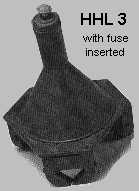 were
basically enlarged Panzerhandminen. The single important type, the Hafthohlladung
3, had a shaped charge of 1.5kg that could penetrate 140mm of armor,
had a diameter of 15cm; with it's three magnets the weapon was 27.5 cm
tall. the complete weapon weighed 3kg; the magnets exerted an attachment
force of 45 kg. To arm the weapon, the Sprengkapsel 8 ("detonator
cap") detonator and the time fuse had to be inserted into the top.
The weapon detonated after 7.5 seconds. The first shaped charges of the
HHL 3 were hemispherical; later the shaped charge was improved to
a more effective tapered / conical shape of 1.7kg resulting in a total
weight of now 3.5kg. 553,900 were produced.
were
basically enlarged Panzerhandminen. The single important type, the Hafthohlladung
3, had a shaped charge of 1.5kg that could penetrate 140mm of armor,
had a diameter of 15cm; with it's three magnets the weapon was 27.5 cm
tall. the complete weapon weighed 3kg; the magnets exerted an attachment
force of 45 kg. To arm the weapon, the Sprengkapsel 8 ("detonator
cap") detonator and the time fuse had to be inserted into the top.
The weapon detonated after 7.5 seconds. The first shaped charges of the
HHL 3 were hemispherical; later the shaped charge was improved to
a more effective tapered / conical shape of 1.7kg resulting in a total
weight of now 3.5kg. 553,900 were produced.
Previous Page : Rifle Grenades
& Related Weapons Main
Page Next
Page : Mortars
© 1998, 1999, 2000, 2001 created by M.Hofbauer August
29th 1998; document ver. 1.4 mod 150102
This page has been constructed with own material as far
as possible, the third party images and information used herein are public
domain to the best of my knowledge. The author went to considerable lengths
to ensure accordance with the rights of copyright owners where applicable;
respective consent is documented. If you feel injured in your rights by
/ take offense at - any part of this page's content contact
me immediately for redress / possible removal of the respective part.
 Handgrenades
are often used against tanks, usually not due to any special AT capability
of these weapons but because of their availability. Although a regular
handgrenade could not kill a healthy full-grown tank it might damage it
esp. immobilize it with a lucky explosion in the track. But there were
also special AT handgrenades dedicated to fight armor.
Handgrenades
are often used against tanks, usually not due to any special AT capability
of these weapons but because of their availability. Although a regular
handgrenade could not kill a healthy full-grown tank it might damage it
esp. immobilize it with a lucky explosion in the track. But there were
also special AT handgrenades dedicated to fight armor. The
most famous german hand grenade is probably the Stielhandgranate 24
("stick hand grenade"), often referred to as the stick grenade
or the potato masher by allied soldiers. The grenade's time fuse was activated
by unscrewing the bottom and pulling the Abreisszünder ("rip
detonator") safety cord (see picture at right). It weighed 480g, had
an overall length of 35.6cm and had a warhead with a length of 7.5 cm and
a diameter of 6cm that contained 165g of explosives (different explosives
were used over the course of the war).
The
most famous german hand grenade is probably the Stielhandgranate 24
("stick hand grenade"), often referred to as the stick grenade
or the potato masher by allied soldiers. The grenade's time fuse was activated
by unscrewing the bottom and pulling the Abreisszünder ("rip
detonator") safety cord (see picture at right). It weighed 480g, had
an overall length of 35.6cm and had a warhead with a length of 7.5 cm and
a diameter of 6cm that contained 165g of explosives (different explosives
were used over the course of the war).
 by
the troops although this designation is rather colloquial and was actually
semi-officially in use for an engineer weapon. The complete weapon combination
looked like a flower with the grenade stick of the central Stielhandgranate
as the stalk and the Hd.Gr.43 warheads surrounding it like petals (see
sketch at right). It was often used as an improvised makeshift AT weapon.
by
the troops although this designation is rather colloquial and was actually
semi-officially in use for an engineer weapon. The complete weapon combination
looked like a flower with the grenade stick of the central Stielhandgranate
as the stalk and the Hd.Gr.43 warheads surrounding it like petals (see
sketch at right). It was often used as an improvised makeshift AT weapon. A
smaller handgrenade was the Eihandgranate 39 ("egg hand grenade").
It weighed only 230g and contained 112g of explosives; it's small size
reduced the lethality of the weapon but greatly improved handling and conveniant
stowage. Having a length of 7.6cm and a diameter of 6cm, a total of 84
Mio. Ei-Hdgr. 39 were produced beginning in early 1940.
A
smaller handgrenade was the Eihandgranate 39 ("egg hand grenade").
It weighed only 230g and contained 112g of explosives; it's small size
reduced the lethality of the weapon but greatly improved handling and conveniant
stowage. Having a length of 7.6cm and a diameter of 6cm, a total of 84
Mio. Ei-Hdgr. 39 were produced beginning in early 1940. 
 had
trouble stabilizing the flight which was necessary for the shaped charge
to work (this lead to the development of the
had
trouble stabilizing the flight which was necessary for the shaped charge
to work (this lead to the development of the  The
SS-weapon's academy then invented the HL-Handgranate that was also
often referred to as the SS-HL-Handgranate to denominate it's inventor
(see pictures at left and right). It had a length of 19cm, weighed 420g
including the shaped charge of 210g and had a diameter of 7.2 cm. It's
front consisted of a felt disc which was 6mm thick and drenched with glue.
The idea was to run up to the tank and stick the grenade onto the armor.
This method to attach the AT grenade to the tank proved to be less practical
than intended, the weapon proved rather unsuccessful and unpopular, therefore
further developments centered around the
The
SS-weapon's academy then invented the HL-Handgranate that was also
often referred to as the SS-HL-Handgranate to denominate it's inventor
(see pictures at left and right). It had a length of 19cm, weighed 420g
including the shaped charge of 210g and had a diameter of 7.2 cm. It's
front consisted of a felt disc which was 6mm thick and drenched with glue.
The idea was to run up to the tank and stick the grenade onto the armor.
This method to attach the AT grenade to the tank proved to be less practical
than intended, the weapon proved rather unsuccessful and unpopular, therefore
further developments centered around the  Because
of the problems to stabilize the dedicated anti-tank grenades for flight
- the shaped charge needed to be pointed straight at the armor to work
efficiently - the Panzerwurfmine ("tank throw mine") or
PWM (L) (L for "lang" = "long") was developed
by the Luftwaffe weapon's bureau (the Luftwaffe also contained ground forces
in the form of it's field units and the paratroopers).
Because
of the problems to stabilize the dedicated anti-tank grenades for flight
- the shaped charge needed to be pointed straight at the armor to work
efficiently - the Panzerwurfmine ("tank throw mine") or
PWM (L) (L for "lang" = "long") was developed
by the Luftwaffe weapon's bureau (the Luftwaffe also contained ground forces
in the form of it's field units and the paratroopers).  First
use of the PzHM 3 was in the battles at the Wolchow in russia in
May 1942; production and destruction figures are unknown.
First
use of the PzHM 3 was in the battles at the Wolchow in russia in
May 1942; production and destruction figures are unknown. were
basically enlarged Panzerhandminen. The single important type, the Hafthohlladung
3, had a shaped charge of 1.5kg that could penetrate 140mm of armor,
had a diameter of 15cm; with it's three magnets the weapon was 27.5 cm
tall. the complete weapon weighed 3kg; the magnets exerted an attachment
force of 45 kg. To arm the weapon, the Sprengkapsel 8 ("detonator
cap") detonator and the time fuse had to be inserted into the top.
The weapon detonated after 7.5 seconds. The first shaped charges of the
HHL 3 were hemispherical; later the shaped charge was improved to
a more effective tapered / conical shape of 1.7kg resulting in a total
weight of now 3.5kg. 553,900 were produced.
were
basically enlarged Panzerhandminen. The single important type, the Hafthohlladung
3, had a shaped charge of 1.5kg that could penetrate 140mm of armor,
had a diameter of 15cm; with it's three magnets the weapon was 27.5 cm
tall. the complete weapon weighed 3kg; the magnets exerted an attachment
force of 45 kg. To arm the weapon, the Sprengkapsel 8 ("detonator
cap") detonator and the time fuse had to be inserted into the top.
The weapon detonated after 7.5 seconds. The first shaped charges of the
HHL 3 were hemispherical; later the shaped charge was improved to
a more effective tapered / conical shape of 1.7kg resulting in a total
weight of now 3.5kg. 553,900 were produced.